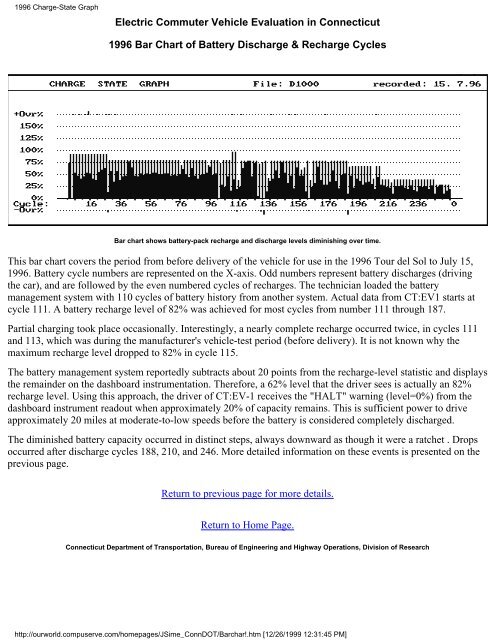Evaluation of Electric Vehicles as an Alternative for Work Trip and ...
Evaluation of Electric Vehicles as an Alternative for Work Trip and ...
Evaluation of Electric Vehicles as an Alternative for Work Trip and ...
You also want an ePaper? Increase the reach of your titles
YUMPU automatically turns print PDFs into web optimized ePapers that Google loves.
1996 Charge-State Graph<br />
<strong>Electric</strong> Commuter Vehicle <strong>Evaluation</strong> in Connecticut<br />
1996 Bar Chart <strong>of</strong> Battery Discharge & Recharge Cycles<br />
Bar chart shows battery-pack recharge <strong>an</strong>d discharge levels diminishing over time.<br />
This bar chart covers the period from be<strong>for</strong>e delivery <strong>of</strong> the vehicle <strong>for</strong> use in the 1996 Tour del Sol to July 15,<br />
1996. Battery cycle numbers are represented on the X-axis. Odd numbers represent battery discharges (driving<br />
the car), <strong>an</strong>d are followed by the even numbered cycles <strong>of</strong> recharges. The technici<strong>an</strong> loaded the battery<br />
m<strong>an</strong>agement system with 110 cycles <strong>of</strong> battery history from <strong>an</strong>other system. Actual data from CT:EV1 starts at<br />
cycle 111. A battery recharge level <strong>of</strong> 82% w<strong>as</strong> achieved <strong>for</strong> most cycles from number 111 through 187.<br />
Partial charging took place occ<strong>as</strong>ionally. Interestingly, a nearly complete recharge occurred twice, in cycles 111<br />
<strong>an</strong>d 113, which w<strong>as</strong> during the m<strong>an</strong>ufacturer's vehicle-test period (be<strong>for</strong>e delivery). It is not known why the<br />
maximum recharge level dropped to 82% in cycle 115.<br />
The battery m<strong>an</strong>agement system reportedly subtracts about 20 points from the recharge-level statistic <strong>an</strong>d displays<br />
the remainder on the d<strong>as</strong>hboard instrumentation. There<strong>for</strong>e, a 62% level that the driver sees is actually <strong>an</strong> 82%<br />
recharge level. Using this approach, the driver <strong>of</strong> CT:EV-1 receives the "HALT" warning (level=0%) from the<br />
d<strong>as</strong>hboard instrument readout when approximately 20% <strong>of</strong> capacity remains. This is sufficient power to drive<br />
approximately 20 miles at moderate-to-low speeds be<strong>for</strong>e the battery is considered completely discharged.<br />
The diminished battery capacity occurred in distinct steps, always downward <strong>as</strong> though it were a ratchet . Drops<br />
occurred after discharge cycles 188, 210, <strong>an</strong>d 246. More detailed in<strong>for</strong>mation on these events is presented on the<br />
previous page.<br />
Return to previous page <strong>for</strong> more details.<br />
Return to Home Page.<br />
Connecticut Department <strong>of</strong> Tr<strong>an</strong>sportation, Bureau <strong>of</strong> Engineering <strong>an</strong>d Highway Operations, Division <strong>of</strong> Research<br />
http://ourworld.compuserve.com/homepages/JSime_ConnDOT/Barchar!.htm [12/26/1999 12:31:45 PM]
















